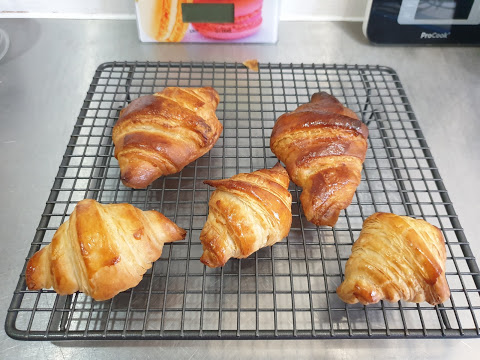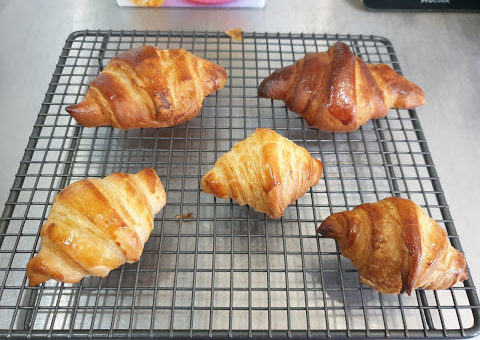Few bakes goods are as quintessentially French as the croissant. One of life’s great pleasures is tucking into layer upon layer of buttery, flaky pastry. But what if I told you their roots can be traced back to outside of France? As I touched on in my pain au raisin article, croissants belong to the category of patisserie known as viennoiserie, as in Viennese pastry. That’s right, the pastries we know and love today were influenced by earlier bakes from Austria.
History
Many legends surround the history of the croissant, which Jim Chevallier discusses in his book August Zang and the French Croissant: How Viennoiserie came to France.
One such myth was that the croissant was popularised by Marie Antoinette who, having tried the pastry in Austria, missed them when she left to marry Louis XVI and sent for an Austrian baker to teach French chefs how to make them. Chevallier dismisses this theory for several reasons. While she was alive in the 18th century, no mention of croissants was made before 1850.
Another theory attributes the siege of Vienna to the birth of the croissant in 1683. As the tale goes, Viennese bakers working late at night heard the Turks tunnelling into the city and raised the alarm. The bread was invented in the shape of the Turkish crescent. However, there are no period sources to confirm this and the alarm had already been sounded elsewhere.
So where does that leave us? Chevallier tells us that in 1838 August Zang set up the Boulangerie Viennoise in Paris. Customers flocked to buy Vienna bread, which was richer than French bread due to the use of milk and eggs. One such bread was the kipfel, a crescent-shaped roll. During the mid-nineteenth century references began to be made to the croissant in France and in 1863 croissant appeared in the French dictionary as a crescent-shaped bread or cake. Zang is also credited with introducing the steam oven to France, which gave his bakes a delicious shine. In response to his bakery’s popularity, other Viennese bakeries soon began to pop up and the rest is history.
The croissant as we know it today is however, very different to the kipfel. Puff pastry did exist at the time, but specific details of the marriage of the two remains a mystery.

Baking
The recipe I translated is by Mercotte. France’s answer to Prue Leith. She is a judge on Le Meilleur Patissier alongside her husband Cyril Lignac. This is a standard croissant recipe, involving the usual puff pastry techniques.
French flour, that old chestnut. The recipe asks for a blend of T55 flour (plain flour) and farine de gruau. Some online references equate gruau flour to 00 flour. However, others refer to it as a specific French croissant and brioche flour or French pastry flour, explaining that it is a blend of high-protein varieties. I used plain flour for mine and it seemed to work fine, although I’m intrigued about the difference blending it with French pastry flour could make.
Translation
Where I expected the recipe to use the word pâte, interestingly it used détrempe. It is clear from the context that this refers to the dough, but it specifically means the puff pastry dough before the butter has been added for lamination. English doesn’t distinguish between these two stages so I was fine to use ‘dough’ here.
Once the dough has proved you are asked to dégazer en l’écrasant avec le poing, literally degas it by crushing it with your fist. Ecraser can mean to squish, squash, flatten, crush, and more. While it is useful to have a visual description of punching the dough to knock the air out, generally this isn’t usually seen in recipes and ‘knock back’ is understandable enough.
Étaler le beurre en rectangle, press the butter into a rectangle. The word étaler has several meanings, as previously described, from roll out, stretch, etc. but here ‘press’ works best as the butter will be cold and not very pliable.
The recipe explains that the pastry can be used for other bakes, such as pain au chocolat and a mysterious chinois. This may refer to chinois feuilleté, a type of brioche made with crème pat and chocolate chips.
Homemade croissants are divine but definitely take some persistence and skill. This is probably my fifth attempt over many years, yet they are still not perfect. This batch are a little small for my liking, though faithful in texture to a standard croissant. One benefit of making a large batch is that they can be frozen after shaping, defrosted overnight for the final prove and baked fresh on the morning. However, in my experience they rarely rise as much this way. Perhaps some more yeast is in order. Something to keep practicing and perfecting…




